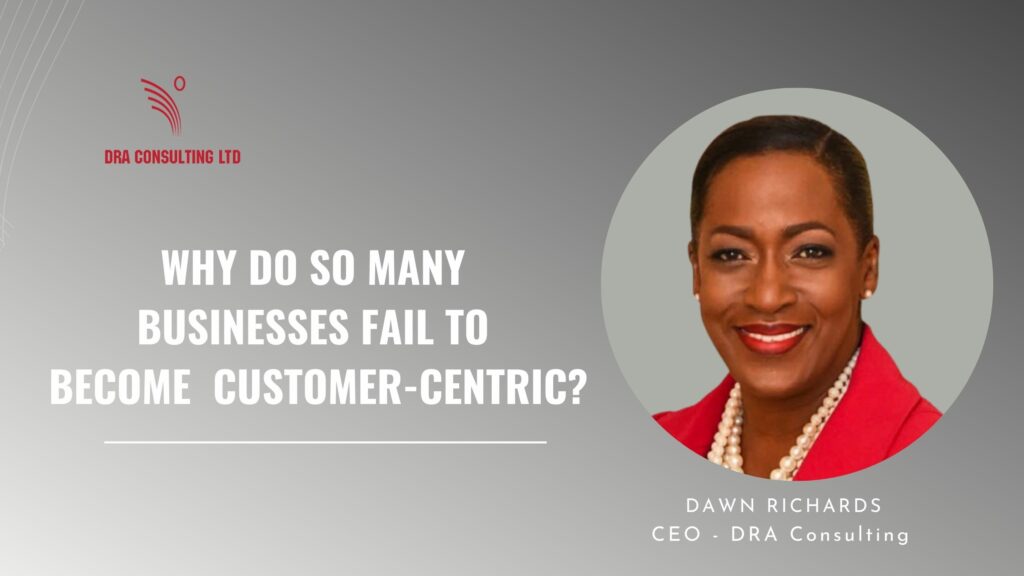The answer to this question is pretty simple. Because they fail to understand customer-centricity in its entirety and therefore, are ill-prepared to commit to the work required to make it a way of life. Actually, if more businesses understood how many features of business operations impact service delivery, there would likely be fewer businesses chanting the mantra of wanting to be “customer-centered.” They would be way too overwhelmed by the required input effort.
Do you remember the phrase, “Everybody wants to go to heaven, but nobody wants to die?” Well, here’s another for you to ponder. “Every business wants to be customer centric, but few are prepared to follow customer centric practices.” In many cases, business fail before they even start the journey to customer centricity.
The answer to this question is pretty simple. Because they fail to understand customer-centricity in its entirety and therefore, are ill-prepared to commit to the work required to make it a way of life.
So, let’s start with a simple definition of customer-centricity. It’s when a business organizes its entire operations around the single vision of making and keeping customers happy. Notice maximizing revenue, meeting sales targets, getting the marketing strategy right, or any other exclusive area of business operation was not singled out for individual mention in the definition. That’s because a customer-centric business understands that, pretty much like baking a cake, it’s about blending the inputs to deliver a cohesive output. In this case, no individual area of operation takes precedence over another. They all play a significant part in the mix and getting “the mix” right is the ikigai of the blend.
When an existing business that has been under-serving and under-satisfying its customers decides to become a customer centric entity, its business model will need to be adjusted in a revolutionary way. Let me highlight some of the elements that should be subject to early reengineering.
First of all, “excellence as an overarching value” should be the glue that will hold the re-envisioned entity in place. Everything about the business should be centered around doing things well, with precision and with the intention of getting tasks right the first time.
“Every business wants to be customer centric, but few are prepared to follow customer centric practices.”
Next, the tired old values of teamworking, mutual respect and communication should be taken down from the walls of the business, because these should be standard practices that are part of the core of “every” business. No need to remind people of what should be naturally occurring practices. Now, I’m aware that these values are not always part of the functional anatomy of every business, so my suggestion is that no effort should be spared to ensure that they become intrinsic to the fabric of the culture. Once done, creative values that will act as propellers for the future of the business, should be carved and infused into business operations. In other words, go for unique values that are aligned to the unique operations of the business.
Have you realized that we have only touched on two structural pillars in the re-engineering of the business model so far? Hopefully, I’ve begun to make my point about how challenging turning around a model that is not customer-centric can be.
Another pillar would be to normalize an “outward mindset” across the business. This means that all decisions that will impact the customer, will have to consider the customer’s needs, wants, likes, preferences and expectations. Here’s where anecdotal decision-making loses credibility and analytics offer a more robust platform for taking decisions that are close to the customer.
When an existing business that has been under-serving and under-satisfying its customers decides to become a customer centric entity, its business model will need to be adjusted in a revolutionary way.
On the operational side, a major imperative would be for all departments to work in an effective system of “horizontal collaboration.” There must be zero silo operations and a seamless interconnectedness of departmental operations. Traditionally, businesses are not set up to be the sum of their individual functions, where collaboration comes naturally to the internal network and there is a smooth resolution of needs. Hence the pervasiveness of silos.
It’s easy to spot a customer-centric business from the outside. Customers experience an effortless journey, no friction, convenience, efficient self-service options, an array of payment solutions, effective customer support and speedy resolution of queries. Getting to this state requires unthinking service delivery modelling and delinking from old practices that do not propel customer centricity.
In many ways, the pandemic forced us to unthink how business could be conducted. Businesses heeded the call, for their very survival depended on accelerating the online revolution.
A new acceleration is looming in the area of customer centricity and service revolution.
Why? Because service activism is on the rise and its goal is to get businesses to become obsessed with keeping the customer happy.
Stay tuned.

